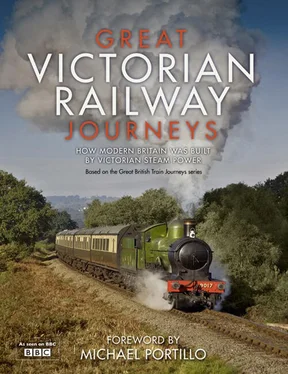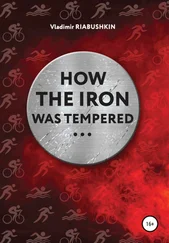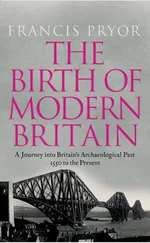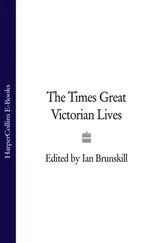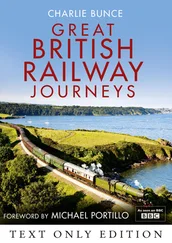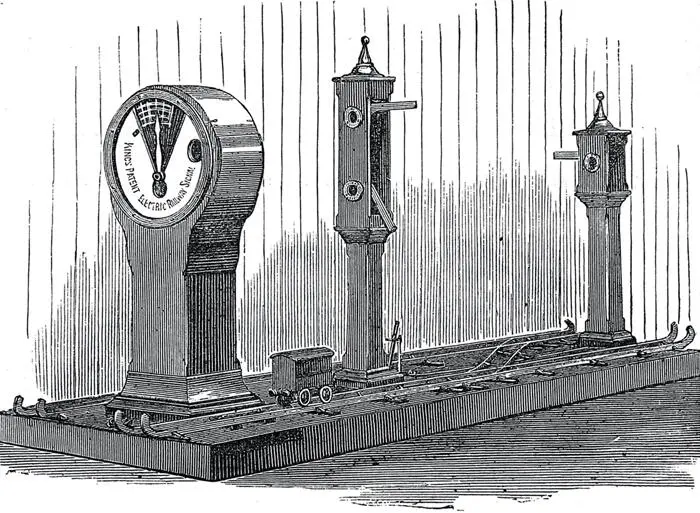
© Illustrated London News Ltd/Mary Evans
An electric signal for railways invented by a Mr King of Paxton, Derbyshire and exhibited at the Crystal Palace Electric Exhibition in 1882. The signal worked by passing electricity through a series of signal-posts placed along a railway line, which would activate a clock hand demonstrating the length of time elapsing between trains.
There’s no doubt that railways were evolving throughout the Victorian era, although not as quickly as some had hoped. Bigger engines were soon hauling more carriages, increasing capacity and cutting costs. However, they weren’t going much faster than early models. Until braking issues were resolved drivers were compelled to travel more slowly than they might have liked.
Steel rails were introduced at a junction outside Derby by the Midland Rail Company in 1857. They replaced wrought-iron rails that were so subject to wear and tear they were renewed every six months. Ten years later the steel rails, which carried about 500 trains daily, were still in use. Steel rails enhanced the comfort of passengers, too, making for a smoother ride, and soon steel was used in bridges and in locomotive manufacture after industrial advances made it cheap to produce.
If safety was a worry for passengers it was an even bigger issue among railway staff. In the 1870s an average of 750 railway employees were killed each year as managers turned a blind eye to even basic safety measures. However, advances in signalling did mean there were fewer collisions.
In early railway history, signalling was rudimentary and varied between companies. Alarmingly, two red discs on a hand-held wand indicated the line was ‘all clear’ on the Great Western while the same signal meant ‘danger’ on the London & Birmingham. Although flag-wavers were placed along busy lines, most drivers could only hope to stop in time if they saw danger ahead and could muster sufficient braking power.
A system of ‘blocks’ was then devised. Tracks were divided into a series of blocks and a train was only given permission to proceed if the block ahead was empty. At first signallers allowed 10 minutes between trains – although they still could not be sure the line ahead was empty. The number of trains permitted to run was duly curtailed. Soon railway managers pushed for the time gap to be reduced and, as a consequence, the number of accidents increased again.
The introduction of the telegraph brought about automatic signalling, in use from the 1840s. Soon the rail-side flag waver was replaced by a signalman who had his own dedicated space at the station. Typically, a weather-boarded box stood in a commanding position at one end of the platform after the 1860s, and by 1900 there were more than 13,000 in use all over Britain.
When he was president of the Board of Trade in the mid-1840s, William Gladstone set about involving government in the higgledy-piggledy railway administration. However, railway companies were staunchly opposed to sharing profits and power with government and used their political leverage to scotch the plans. Eventually, the Railway Clearing House (RCH) was instituted in 1842 to sort out who owed what to whom as a result of long-distance railway journeys. Railway companies were invited to join, although the RCH didn’t achieve national coverage for more than 20 years.
Mostly the RCH accountants relied on honesty. However, an army of some 500 men were regularly dispatched to sit at key railway junctions noting every carriage and wagon that went by. For such perilous work they were relatively poorly paid, out in all weathers, and worked 13-hour shifts. High standards were generally expected of railway workers, as the 1856 rulebook issued by the Taff Vale Company reveals.
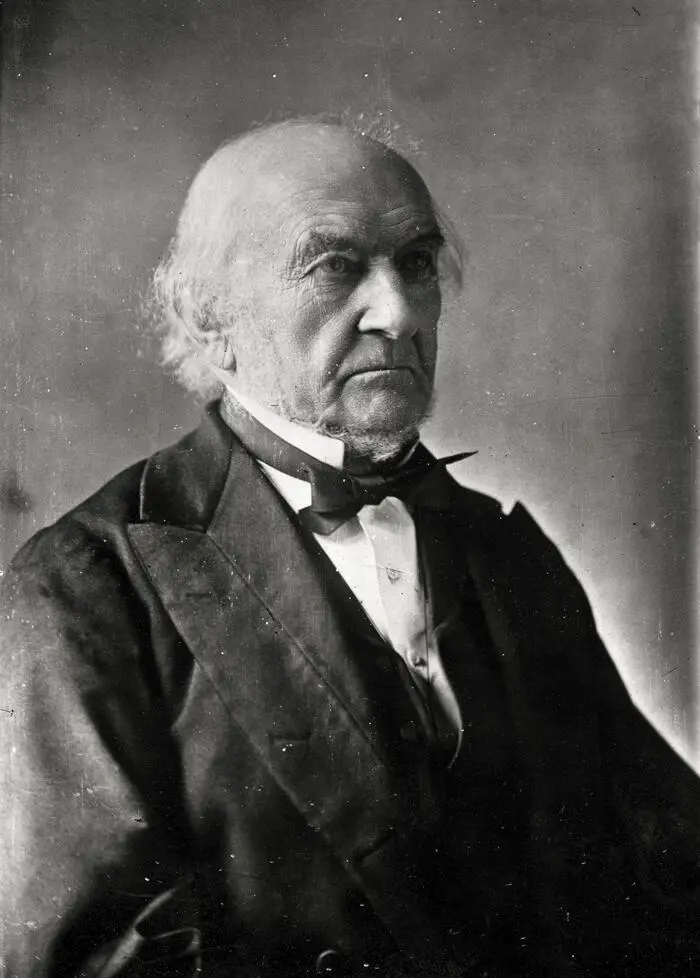
© Illustrated London News Ltd/Mary Evans
William Ewart Gladstone (1809–1898).
Every person is to come on duty daily, clean in his person and clothes, shaved, and his shoes blacked.
It is urgently requested every person … on Sunday and Holy Days, when he is not required on duty that he will attend a place of worship; as it will be the means of promotion when vacancies occur.
(In addition, singing, whistling, laughing and political activity were banned. No one could become a stationmaster unless he was married, and all staff had to salute officers and directors.)
The difference in gauges across the networks was another issue that needed a national view. Confusion reigned at Gloucester station, where the broad-gauge Great Western Railway met the rest. Every passenger, animal and pound of freight had to make a change. Brunel had proved his broad gauge was superior when it came to speed, hauling an 80-ton load at almost 60 mph on one occasion. But the Royal Commission established to investigate railway gauges thought there was more to the argument than mere speed. It was cheaper to make a broad gauge narrow than vice versa, and there was already much more standard gauge on the ground than broad. Consequently, standard gauge was required by law in all railways built after 1846, although the Great Western Railway didn’t say farewell to its wide lines entirely until 1892.
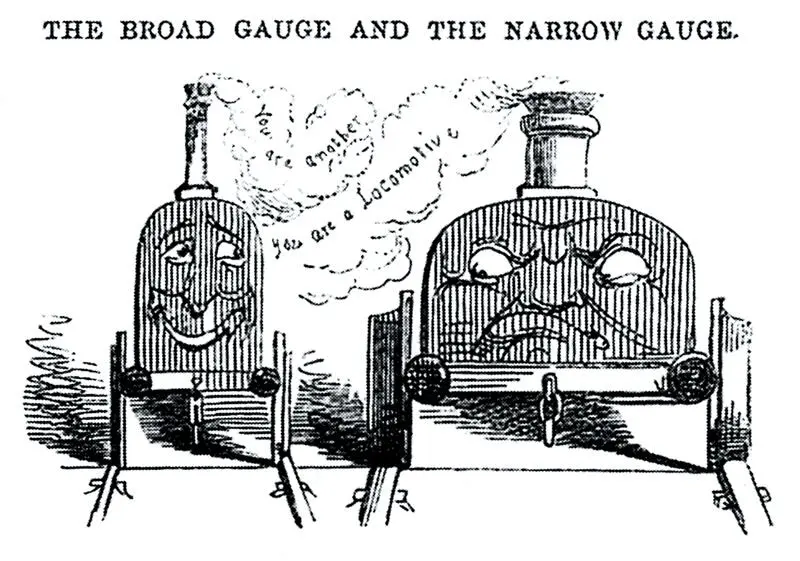
© Lordprice Collection/Alamy
‘Gauge War’: an 1845 cartoon by Angus Reach on the conflict between the broad gauge of the Great Western Railway and the narrow gauge.
The railways gave impetus to ship building, dock trade, harbours, hotels and the leisure industry. They modified everyone’s lives and existing businesses beyond recognition.
Immense changes were made in the postal system, for example. Before the advent of the railways letters and parcels were transported with comparative speed by horse-drawn mail coaches that travelled across the nation. However, it was soon apparent that trains would do the same job more quickly and soon mail coaches became second-rate alternatives to rail.
Enterprising postal chiefs soon realised that trains could not only deliver the mail more rapidly but could be used as travelling sorting offices to further speed the progress of the post. As early as 1838 mail was sorted in a moving train, on this occasion a carriage made from a converted horse-box, on the Grand Junction Railway. The idea was seized upon by other services and incorporated into trains. These were first known as Railway Post Offices and later as Travelling Post Offices or TPOs.
From 1852 the mail bag pick-up apparatus became a common sight at the side of main lines. Aboard the train, postal workers secured letters inside leather pouches weighing anything between 20 and 60 lb (9–27 kg). These were attached to hinged metal arms that could swing out through open doors, dangling the pouch a few feet above the ground and several feet from the side of the carriage. A robust line-side net then scooped up the pouch and the metal arm retracted. To pass mail to a train, a postman positioned similar leather pouches in nets by the tracks so an arm from the train could ‘catch’ them and toss them through the open doors into the train.
Today it seems an old-fashioned and inefficient way to exchange mail, yet the system was used throughout Victorian times and well into the twentieth century, until 1971.
Throughout the era, the volume of post continued to increase thanks to a uniformity imposed by Sir Rowland Hill, who published his pamphlet Post Office Reform in the year Victoria came to the throne. Hill saw that, thanks to the railways, mail could be distributed with increasing ease across the nation. If the cost was kept low more people than ever would use the service, he predicted. By 1840 the Penny Black stamp, bearing the profile of Queen Victoria and snipped from a sheet with scissors, came into use. Within a few years the first Christmas card was sent. By the mid-1850s pillar boxes were appearing on street corners to aid the collection of mail, and by Victoria’s death there were some 32,500 pillar boxes in the UK. Without the age of the train, it is difficult to see how the postal service would have proliferated.
Читать дальше
